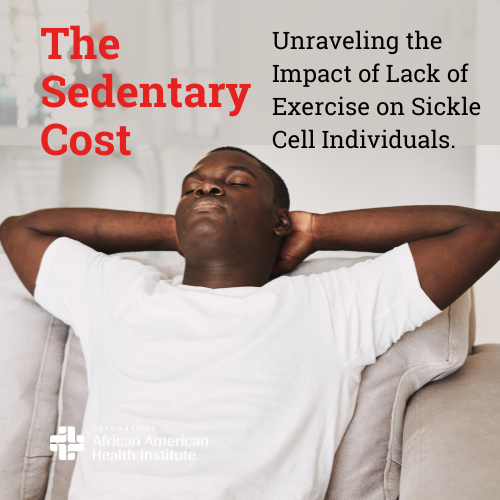As discourse on Sickle Cell Disease (SCD) evolves, attention increasingly turns to the critical role of lifestyle choices, particularly physical inactivity, in influencing the disease’s trajectory and the overall quality of life for those affected. The benefits of moderate physical exercise are well-documented; however, individuals with SCD face unique challenges that often prevent them from engaging in regular physical activities. A significant barrier is the increased risk of triggering crises, which account for more than 230,000 SCD-related hospital admissions annually in the United States, resulting in an estimated financial cost of $2.4 billion (Lanzkron et al., 2010; Ballas and Lusardi, 2005). Consequently, a sedentary lifestyle is notably common among this population. Therefore, the question arises: what are the consequences for individuals with SCD who lead such a lifestyle?
Firstly, a sedentary lifestyle contributes to increased blood viscosity (Copolla et al., 2004; Nader et al., 2019), a condition that exacerbates the sickling process of red blood cells. Exercise promotes better circulation and plays a critical role in reducing blood viscosity, which in turn lowers the risk of crises. These crises are likely to decrease in individuals with SCD who engage in regular, moderate physical activity. Thus, the absence of exercise not only forfeits this protective benefit but also enhances the propensity for such debilitating episodes.
Lifestyles characterized by low levels of physical activity are linked to a higher risk of heart disease and increased mortality rates (Kruger et al., 2003; Piel et al., 2017; Melo et al., 2021). The efficiency of oxygen transport throughout the body plays a pivotal role in heart health, and regular exercise markedly enhances this process. For individuals with conditions such as Sickle Cell Disease (SCD), a deficiency in physical activity can exacerbate cardiovascular efficiency. Given the already impaired capacity of sickled cells to transport oxygen, any further decrease in oxygen delivery can precipitate more severe health complications (Nyante et al., 2019) which could include acute chest syndrome (ACS) and Community-Acquired Pneumonia.
The connection between physical inactivity and sickle cell disease (SCD) highlights deep-seated health challenges that go beyond the disease’s immediate effects. For example, a sedentary lifestyle, which is prevalent among individuals with SCD, often leads to obesity, which can exacerbate other health conditions. Intriguingly, even though young individuals with SCD tend to burn more calories at rest, a significant portion—ranging from 19% to 22% are overweight or obese (Chawla et al., 2013; Zivot et al., 2017), mirroring obesity trends in the general US population (Hales et al., 2017). Within this segment, 16% are children and 26% are adolescents (Mitchell et al., 2009). These figures shift the focus from the historically emphasized issues of undernutrition and stunted growth within the Sickle Cell Disease (SCD) community to underscore a vital area of concern: weight management for these patients. The rising incidence of overweight and obesity, especially among young people with SCD, is alarming. This trend increases their risk of developing conditions such as hypertension and stroke, which could further burden their already at-risk cardiovascular system. Additionally, obesity in SCD patients is associated with reduced mobility, and inactivity leads to reduced bone density, a predisposing factor for osteoporosis and fractures (Sadat-Ali et al., 2004; Shah et al., 2004; Miller et al., 2006; Ozdemir et al., 2016). These individuals need to be sensitized and encouraged to adopt regular exercise to enhance the overall quality of their lives and steer them away from secondary complications.
Exercise training is universally acknowledged for its anti-inflammatory effects that benefit not just healthy individuals (Pedersen & Hoffman-Goetz, 2000; Pinto et al., 2020) but also those with various health conditions such as respiratory, cardiovascular, and metabolic diseases (Yang & Chen, 2003; Halle et al., 2004; Zoppini et al., 2006; Hamer et al., 2012). This benefit underscores the vital role of physical activity in the management of Sickle Cell Disease which is synonymous with inflammations. Advanced exercise tests that access the combined functionality of the heart, lungs, and muscles under peak exertion do not exacerbate vascular inflammation or edema in children with SCD (Liem et al., 2015). This confirms the safety and potential advantages of judiciously designed exercise regimes in SCD care which cannot amplify major health concerns. Therefore, identifying a balanced, moderate exercise regimen is crucial in effectively managing SCD.
In summary, while the potential for exercise to trigger sickle cell crises and other complications cannot be dismissed, the overarching benefits of a tailored, moderate exercise regimen far outweigh the risks when appropriately managed. The adverse effects of a sedentary lifestyle on individuals with SCD ranging from increased blood viscosity and reduced oxygen delivery to compromised immune function, and poor pain management highlight the critical need for integrating physical activity into the comprehensive care plan for SCD. Such an integration requires a collaborative effort between healthcare providers and patients to devise exercise strategies that are safe, effective, and tailored to individual needs.


